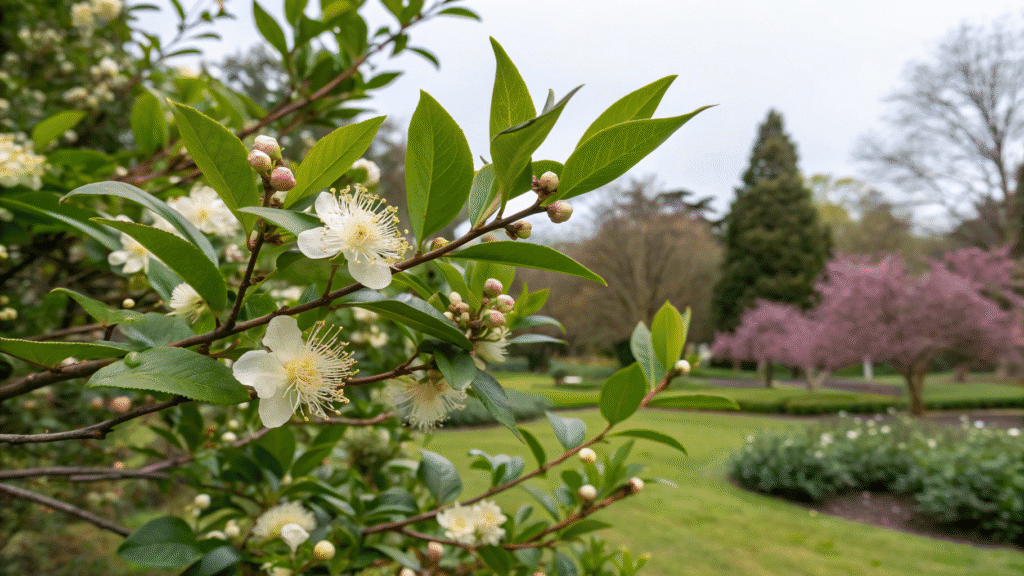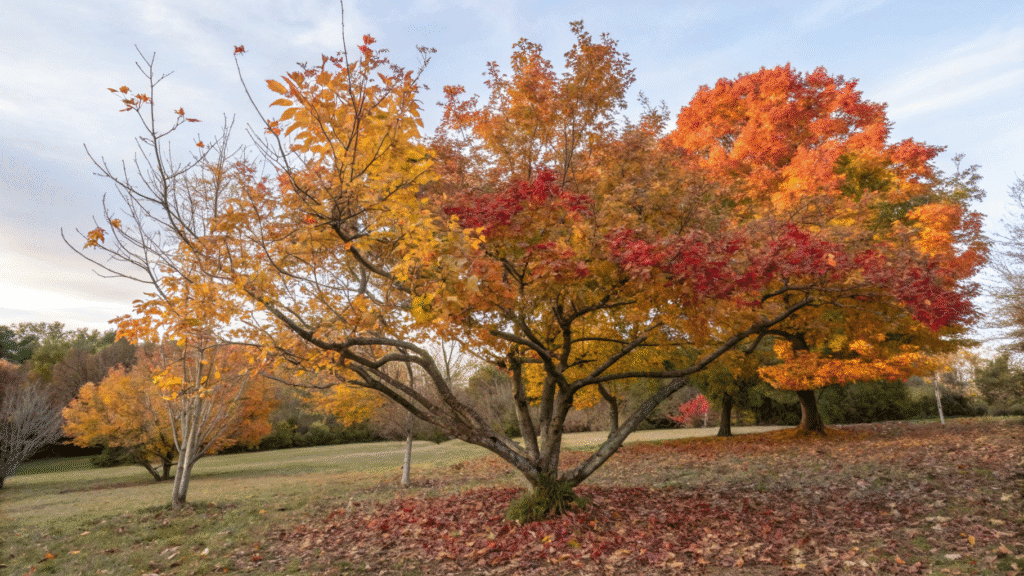Crape myrtles are a go-to choice for gardeners who want a splash of color in their yards. With their bright summer blooms in shades of pink, purple, red, or white, and their colorful fall leaves, these trees can make any landscape pop. But to get those stunning results, planting them at the right time matters a lot.
The wrong season can stress the tree, weaken its roots, or even keep it from flowering.
This guide breaks down the best months to plant crape myrtles in different parts of the U.S., explains what factors to consider, and gives clear steps for planting in spring or fall. For tips on keeping your crape myrtle thriving long-term, check out the detailed guide on “How to Grow a Crape Myrtle Tree“.
Table of Contents
Quick Answer: Best Months to Plant Crape Myrtle by U.S. Region
| Region | Best Planting Months | Notes |
|---|---|---|
| Southern States (Zones 7-9) | March–April, September–October | Mild winters make spring or early fall planting ideal for strong roots. |
| Mid-South (Zone 6) | April–May, September | Stick to early fall to dodge early frosts; spring is often safer. |
| Northern States (Zones 5-6) | May–June | Spring planting gives roots time to settle before winter hits. |
| Coastal Regions | March–May, September–October | Mild weather allows flexibility, but good drainage is a must. |
| Arid Southwest | March–April, October | Skip the hot summer; water regularly to help young trees get established. |
This table is a quick guide, but local weather and soil can shift the best planting time. Let’s look at what affects the timing and how to plant successfully.
What Affects When to Plant Crape Myrtle

Getting the timing right for planting a crape myrtle depends on a few key things. Knowing these helps ensure the tree takes root well and grows strong.
Climate and Hardiness Zones
Crape myrtles do best in USDA Hardiness Zones 6–9, where they handle hot summers and moderate winters like champs.
In southern states like Louisiana or South Carolina (Zones 7–9), you can plant in spring or fall because winters are mild. In colder spots, like parts of Zone 5, spring is the safer bet so the tree has time to settle before winter.
Picking a variety that fits your area—like ‘Dynamite’ for warm zones or ‘Tonto’ for cooler ones—is key. The guide on How to Grow a Crape Myrtle Tree has more on choosing the right type.
Soil Temperature
Crape myrtle roots grow best in warm soil, ideally between 60°F and 70°F. In spring, hold off until the soil is above 55°F to avoid stressing the roots. For fall planting, make sure the soil is still warm, usually 6–8 weeks before the first frost, so the roots can start growing.
Frost Dates
Frost can hurt young crape myrtles before their roots are set. Look up your area’s first and last frost dates through local weather services or your cooperative extension office.
In northern areas, planting too late in fall can leave the tree vulnerable to frost. Southern gardeners have more wiggle room, but early spring cold snaps can still cause problems, so plan carefully.
Local Weather Patterns
Every region has its own weather quirks. In humid places like the Southeast, make sure the soil drains well to avoid soggy roots. In dry areas like Arizona, plant in early spring or fall and water regularly to beat the heat.
Coastal areas often have milder weather, giving you more planting time, but watch out for wet soils that can cause root issues.
Keeping these factors in mind helps you pick the best time to plant your crape myrtle.
How to Plant Crape Myrtle in Spring
Spring is a great time to plant crape myrtles, especially in cooler areas where the tree needs the growing season to get established.

Here’s how to do it:
Step 1: Find a Sunny Spot
Crape myrtles love sunlight—at least 6 hours of direct sun a day is best for lots of blooms. Pick a spot where water doesn’t pool, as these trees don’t like wet feet.
Step 2: Get the Soil Ready
Check the soil’s pH, aiming for 5.5 to 7.5. You can use a home test kit or send a sample to your local extension service. If the soil is heavy clay or too sandy, mix in some compost to improve drainage and add nutrients.
Dig a hole twice as wide and about as deep as the tree’s root ball so the roots have room to spread.
Step 3: Pick a Good Tree
Choose a crape myrtle with a solid trunk and no signs of bugs or disease. Varieties like ‘Muskogee’ for big blooms or ‘Acoma’ for colder areas work well, depending on where you live.
Step 4: Plant the Tree
Set the tree in the hole, making sure the top of the root ball is even with or just above the ground. Fill in with soil, pressing lightly to get rid of air pockets. Water it well to help the soil settle.
Step 5: Mulch and Water
Put a 2–3 inch layer of mulch, like wood chips or bark, around the base, but keep it a few inches away from the trunk to avoid rot. Water once or twice a week for the first month or so, depending on rain.
Step 6: Watch for Issues
Keep an eye out for drooping or yellow leaves, which might mean too much or too little water. Don’t fertilize in the first year to avoid stressing the young roots.
Planting in spring gives the tree time to build strong roots before summer, setting it up for great blooms.
How to Plant Crape Myrtle in Fall
In warmer areas (Zones 7–9), fall is a solid choice for planting, as cooler weather lets roots grow without heat stress.

Here’s the step-by-step:
Step 1: Time It Right
Plant 6–8 weeks before the first frost, usually September or October in southern states. Check local frost dates to make sure there’s enough time for roots to settle.
Step 2: Choose a Good Location
Go for a spot with full sun and soil that drains well. Avoid low areas where water or cold air might sit, as this can harm the tree.
Step 3: Prep the Soil
Test the soil’s pH and add compost if it’s too clay-heavy or sandy. Dig a hole twice as wide and as deep as the root ball to give roots plenty of space.
Step 4: Plant the Tree
Place the tree so the root ball is level with the ground. Fill the hole with soil, press gently, and water deeply to help the roots connect with the soil.
Step 5: Add Mulch
Spread a 3–4 inch layer of mulch to keep the soil temperature steady. Keep it away from the trunk to prevent moisture buildup.
Step 6: Water and Protect
Water once a week if it doesn’t rain, keeping the soil moist but not soaked. In cooler areas, wrap the trunk with burlap to protect it from frost.
Fall planting uses cooler weather to help roots grow strong before the next season.
Mistakes to Avoid When Planting Crape Myrtle
Even if you plant at the right time, a few common errors can trip you up. Here’s what to watch out for:
Planting Too Deep
If the root ball is buried too deep, the roots can struggle to get air and water. Make sure the top of the root ball is at or just above ground level.
Watering Too Much
Crape myrtles need regular water while getting established, but too much can lead to root rot. Feel the soil before watering to check if it’s still moist.
Picking the Wrong Tree
A variety meant for warm climates won’t survive a cold winter. Choose one that fits your hardiness zone to avoid disappointment.
Not Enough Sun
These trees need full sun to bloom their best. Planting in a shady spot can mean fewer flowers and a weaker tree.
Over-Pruning
Cutting back too hard, sometimes called “crape murder,” can hurt the tree and cut down on blooms. Prune lightly in late winter to shape it, not chop it to stubs. For more on pruning, see How to Grow a Crape Myrtle Tree.
Skipping these mistakes helps your crape myrtle grow healthy and full of flowers.
Conclusion
Planting a crape myrtle at the right time sets it up to become a gorgeous part of your yard. In southern states, aim for March–April or September–October, while northern gardeners should stick to May–June to get ahead of winter.
Think about climate, soil warmth, and frost dates, and follow careful planting steps to give the tree a great start. Avoid pitfalls like overwatering or picking a variety that doesn’t fit your area.
For all the details on caring for your crape myrtle, from pruning to pest control, take a look at How to Grow a Crape Myrtle Tree. With the right timing and a little care, your crape myrtle will shine for years.


Leave a Reply